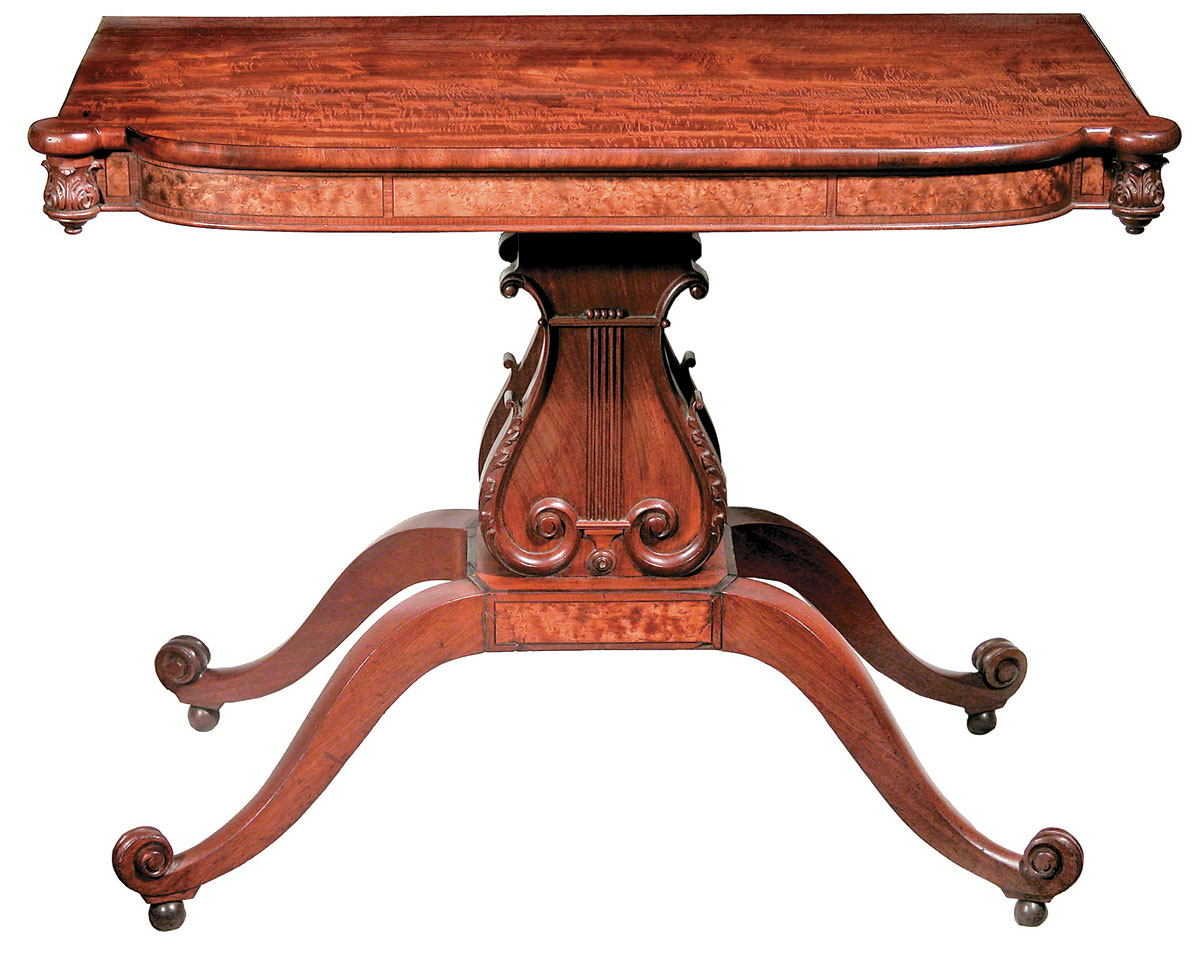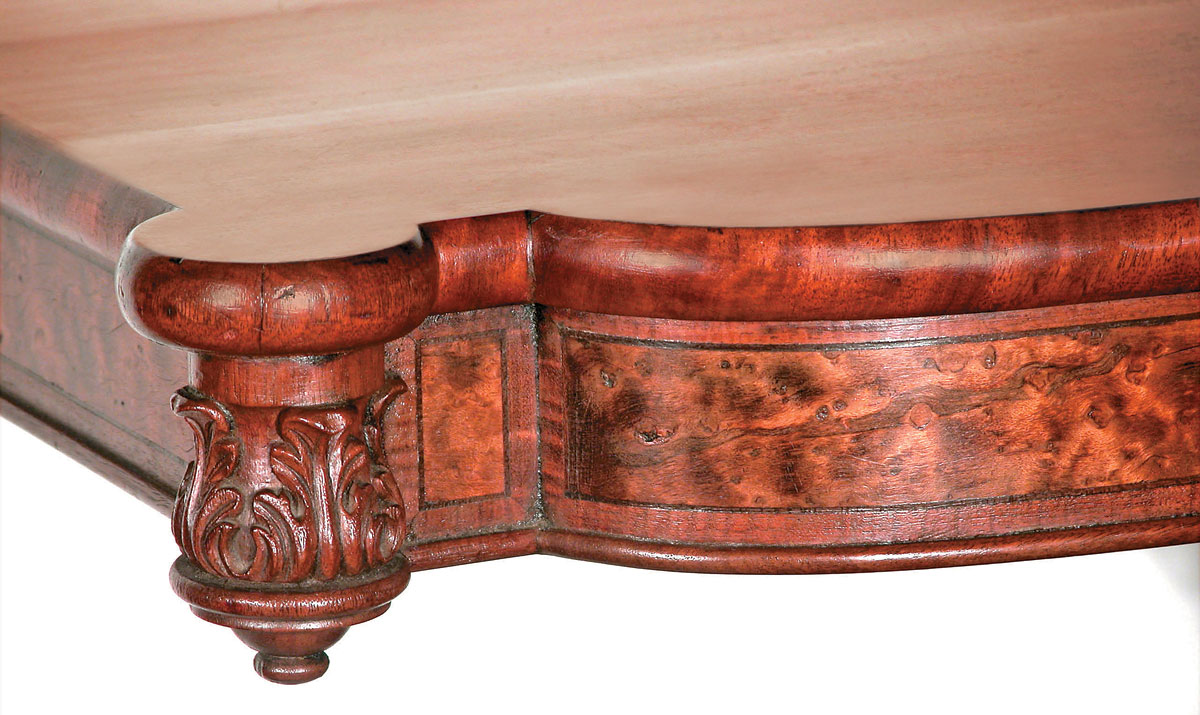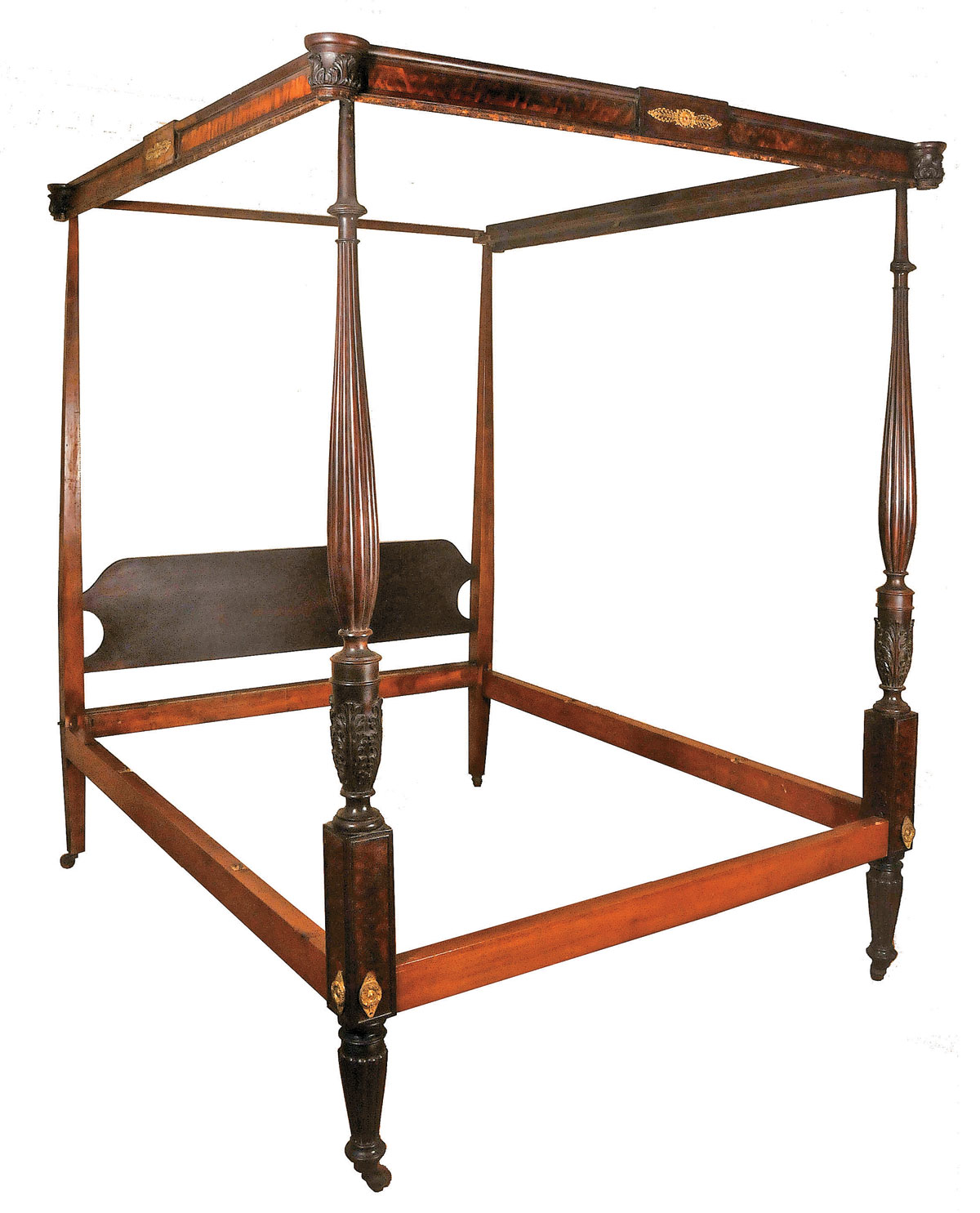Thomas Seymour Lyre-Based Side Table

- Attributed to Thomas Seymour (1771–1848), Lyre-Based Side Table, circa 1812–1817, Boston, Mass. Mahogany and bird’s-eye maple. H. 28-3/4 in. Private collection. Photography courtesy of the Stanley Weiss Collection.
You never know what treasures you will find at antiques shows. This is a tale of the discovery of a rare form, found hiding in plain sight at the Mid-Week in Manchester Antiques Show this past August. When dealer/collector Stanley Weiss walked by one of the booths, he noticed what appeared to be a lyre-based card table. What was unusual is that it had only a single top, not a top with hinged leaf as is typical for card tables. This variation certainly would cause one to pause and question the table’s integrity as a complete antique. However, the dealer exhibiting the table mentioned that a nearly identical example was pictured in volume 1 of Wallace Nutting’s Furniture Treasury (1948). Illustrated in Nutting was what appears to be the same table, with the exception of casters in the place of ebonized wooden ball feet. The Nutting example had an Israel Sack provenance and was incorrectly attributed to Duncan Phyfe of New York City. The dealer at the show had acquired the table on Nantucket.
In determining the original purpose of the table, several observations were considered. The table’s height of 28 ¾ inches—which is typical for game tables—would preclude it from being a server or pier table, both of which are generally several inches higher. It might be a side table, but one does not expect to see a side table in card table form and height. Even though a solid conclusion was not yet reached, given that the price of its purchase was reasonable, the construction appeared correct and unaltered, and the inlays and carving exuding the finest quality, it was purchased and sent off to Robert Mussey Associates of Boston, conservators and the pre-eminent scholars in the field for further scrutiny and analysis.
The design of the table and construction details throughout reflect the precision, refinement, and labor-intensive characteristics typical of furniture made by Thomas Seymour (1771–1848), the leading cabinetmaker of Federal-era Boston. The quality of his work, and its resulting high cost, probably led to his ultimate business failure in 1817. Evidence of his craftsmanship may be seen in the rounded top-edge moldings surrounding the front turret corners of the top. These are not bent around the corners in the usual method, but instead lathe-turned out of solid mahogany. The center of the turned disk was then hollowed out leaving a circular molding that conformed exactly to the curve of the top corners. This time-consuming and expensive method prevented any cracking of the cross-grain molding and the later delamination that often occurred with bent moldings. Note also the triple-beaded moldings applied to the lower edges of the rails. These returns around the carved corners have a similar molding incorporated into the turning pattern. This feature appears again and again in Seymour’s work on his various furniture forms with turned legs.
After further evaluation it was determined that, because of the single top, the table had originally been designed as a side table. This was evidenced by the mahogany cross-grain moldings on the edges of the top, which have continuous grain with no alteration (had there originally been a leaf and hinges, the molding would have been disturbed). Of Seymour’s work from this period, one other side table in card table form is known.1 The other table, a full 36 inches in height, was evidently intended for use as a pier table, probably with a large gilt mirror above. The present table’s lower height confirms its use instead as a side table.
As timing would have it, Robert Mussey had recently evaluated a Seymour bedstead when the table arrived in his studio for examination. The bedstead was a recent discovery, along with fourteen other pieces firmly attributed to Thomas Seymour and found in the house for which they were made. It was quickly noted that the leaf-carved and applied turret corners were exact duplicates of the bed cornice (see details). The carving is in the distinctive crisp style of Seymour’s favorite carver, the London immigrant Thomas Wightman. The leaf carving on the lyres also mimics Wightman’s foliage on other card tables and the curving mirror brackets of several dressing chests with mirrors by Seymour.2 The cornice of the bed similarly features panel inlays of bird’s-eye maple veneer with ebonized stringing borders and curly mahogany crossbanding frames. The secondary wood is principally ash, a choice also unique to Seymour among Boston cabinetmakers. It appears evident that these two pieces of furniture were made in his shop at the same time, and were originally perhaps part of the same suite. Two of the other pieces from the house—a dressing chest with mirror and a basin stand—are in the same style with similar detailing and veneer choices as the bed.
This rare Regency-style table embodies the innovative designs with which Seymour was continually experimenting and introducing to Boston, and reflects his typical meticulous choice of wood and construction methods. Thomas Seymour’s new productions in this later period of his career included numerous types of lyre-base tables, most commonly called “harp-base” in period advertisements. This is merely one of many of his variations on the theme. Some examples incorporated brass wire representing strings. A recently discovered pier table made by Seymour and painted and signed by Boston decorative painter John Penniman (1782–1841), incorporates four superb painted and gilt supporting lyres. Other variants employ lyre-form supports with ebonized veneers inlaid to simulate mock fluting. Another group features rosewood veneers with gilt and painted foliage on both curving lyre-edges. The present example substitutes carved versions of the same leaves along the lyre edges.
—
Robert D. Mussey Jr., Robert Mussey Associates, Boston, Mass. and Stanley Weiss, president of Stanley Weiss Collection, Providence, Rhode Island.
2. See Mussey, cat. no. 66, pp 266–67, a dressing table with mirror.






























